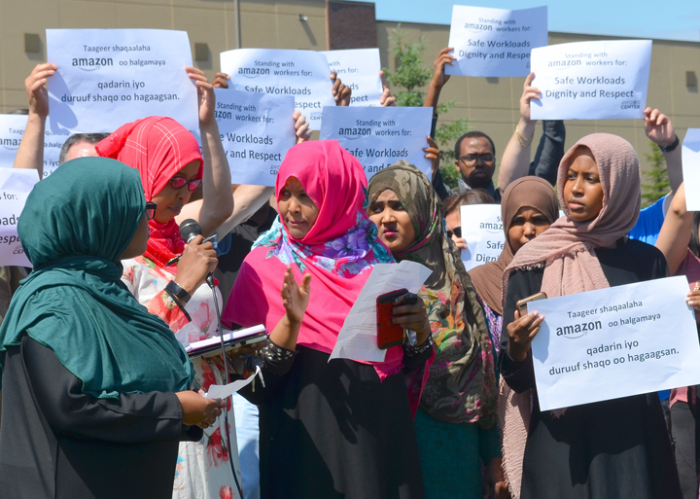

Share
Amazon workers this week echoed the findings of a new report that paints a troubling picture of labor conditions and inequities at the retailer’s Minnesota warehouses, prompting one state lawmaker to pledge action in the coming legislative session.
In analyzing data from six Amazon facilities, researchers from the National Employment Law Project found injury and turnover rates well above the industry average, disparities between the earnings of Black and white workers at some warehouses and work arrangements designed to thwart union organizing.
But Tyler Hamilton, who has worked at the MSP1 facility in Shakopee for four years, said the data “doesn’t surprise those of us who have worked inside those warehouses. We see it every day.”
Hamilton and others active in the Awood Center, a worker-led organization that focuses on issues affecting members of Minnesota’s East African communities, held a virtual press conference Monday to share their reactions to the report, released Dec. 8.
Rep. Emma Greenman, a DFLer from Minneapolis, pledged to hold hearings on Amazon’s labor practices after the Legislature reconvenes in January. She said she is authoring legislation to ensure warehouse workers are provided adequate breaks, safety protections and a voice on the job.
“As Amazon expands here in Minnesota, the Legislature needs to take a look at the human cost,” Greenman said.
RATE DRIVES INJURIES
Workers on the press call targeted the bulk of their frustrations at Amazon’s “rate” – a benchmark for productivity each of them must meet to avoid facing discipline. Dad Ali, a four-year Amazon veteran, recalled appealing to his managers, as they pushed the rate higher and higher, with a traditional Somali saying that humans aren’t horses and shouldn’t be whipped to move faster.
“You’re expected to work like a machine,” Ali said, speaking through an interpreter.
The driving pace, workers and researchers say, is behind Amazon’s abysmal safety record in Minnesota, where Amazon employees are more than twice as likely to be injured as other warehouse workers.
Citing Amazon’s own data, the NELP report found 11.1 injuries annually per 100 full-time-equivalent warehouse workers between 2018 and 2020. At non-Amazon warehouses, that rate was 5.2. The Shakopee facility is particularly dangerous, researchers noted, with an injury rate in 2020 that was higher than any industry in Minnesota.
Irene Tung, a senior researcher at NELP, said most injuries reported in Amazon warehouses were severe muscle strains, which can have lifelong effects. The injuries are also “completely preventable,” Tung said, but that would require easing up on work rates and allowing time to recover between repetitive tasks.
That’s not the Amazon model.
“What makes working at Amazon so much more dangerous than working at other Minnesota jobs is the excessively rapid pace of work, enforced through a distinctive disciplinary system that Amazon has pioneered, which combines intensive electronic monitoring with frequent discipline and termination,” Tung said.
“When everybody’s paranoid about getting written up for not going fast enough, injuries happen,” said Emali Pettey, who worked for Amazon from 2020 to 2021. “That’s what happened with me.”
Workers at Amazon’s Shakopee facility went on strike in July 2019.

THE RUNAROUND
Suffering an injury on the Amazon warehouse floor, Minnesota workers said, is the start of a drawn-out process that too often results in greater injury, unpaid medical bills or lost wages. Speaking through an interpreter, Fardowso Yusuf said the process is known among Amazon workers like her as “the runaround.”
“When I got injured, I was sent home and my injuries were deleted out of the system,” Yusuf alleged. “I couldn’t find any record, and I didn’t receive any payment.”
Yusuf and other workers said they confronted managers with reports from their personal physicians, only to be “told they don’t accept that kind of report,” Yusuf said. Ali said he asked for a reduced workload after his doctor diagnosed him with spinal disc injuries, only to be told by a manager “to go back to work.”
“They don’t take it in a serious manner,” said Ali, who still feels the effects of his injury. “Amazon will give you the runaround until you give up, until you put your hands up and get no results. If you don’t speak [English] that makes it even harder for you.”
TROUBLING DISPARITIES
Indeed, NELP researchers raised questions about Amazon’s disproportionate employment of Black and East African workers in Minnesota. Greenman, a member of the House committee on labor, said those practices should draw greater public scrutiny in light of “Minnesota’s shameful racial inequities.”
In Scott County, where Amazon accounts for the overwhelming majority of warehouse employees, Black warehouse workers take home 37% less, on average, than white warehouse workers. Amazon doesn’t make public average pay rates by race, but Tung said the data suggests Black workers in Scott County are being segregated into lower-paying jobs.
What is clear from the report is that Amazon is not living up to its promise to create high-quality jobs for Minnesotans at its warehouses. If Amazon were, Tung said, its annual turnover rates – which reached 170% at the Shakopee facilities – would not be glaringly higher than other warehouses, which average 61% per year.
Greenman called the Amazon business model “jarring” and said it falls short of Minnesota’s standards.
“It’s a model that uses and discards workers at an alarming rate, with little regard for their health, their economic security, their well-being and the impact it has on our local communities,” she said.

